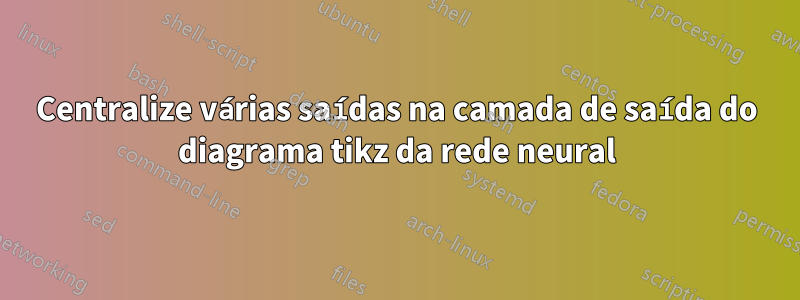
Esta questão está construindo uma solução postadaaqui. O código abaixo deve ser otimizado, pois a camada de saída não está centralizada no resto da figura.
Gostaria de saber como centralizar a camada de saída com o restante da figura.
Além disso, eu queria saber como definir a posição correta da camada de saída em vez de codificá-la da maneira que a possui atualmente:
\node[output neuron, pin=right:Output \#\y] (O-\name) at (4*\layersep,-\y) {};
Aqui está o código que tenho até agora:
\documentclass{article}
\usepackage{tikz}
\begin{document}
\pagestyle{empty}
\def\layersep{2.5cm}
\begin{tikzpicture}[
shorten >=1pt,->,
draw=black!50,
node distance=\layersep,
every pin edge/.style={<-,shorten <=1pt},
neuron/.style={circle,fill=black!25,minimum size=17pt,inner sep=0pt},
input neuron/.style={neuron, fill=green!50},
output neuron/.style={neuron, fill=red!50},
hidden neuron/.style={neuron, fill=blue!50},
annot/.style={text width=4em, text centered}
]
% Draw the input layer nodes
\foreach \name / \y in {1,...,8}
% This is the same as writing \foreach \name / \y in {1/1,2/2,3/3,4/4}
\node[input neuron, pin=left:Input \#\y] (I-\name) at (0,-\y) {};
% set number of hidden layers
\newcommand\Nhidden{3}
% Draw the hidden layer nodes
\foreach \N in {1,...,\Nhidden} {
\foreach \y in {1,...,9} {
\path[yshift=0.5cm]
node[hidden neuron] (H\N-\y) at (\N*\layersep,-\y cm) {};
}
\node[annot,above of=H\N-1, node distance=1cm] (hl\N) {Hidden layer \N};
}
% Draw the output layer node
\foreach \name / \y in {1,...,4}
% This is the same as writing \foreach \name / \y in {1/1,2/2,3/3,4/4}
\node[output neuron, pin=right:Output \#\y] (O-\name) at (4*\layersep,-\y) {};
% How to calculate the exact location of the output layers instead of hardcoding the value
% Connect every node in the input layer with every node in the
% hidden layer.
\foreach \source in {1,...,8}
\foreach \dest in {1,...,9}
\path (I-\source) edge (H1-\dest);
% connect all hidden stuff
\foreach [remember=\N as \lastN (initially 1)] \N in {2,...,\Nhidden}
\foreach \source in {1,...,9}
\foreach \dest in {1,...,9}
\path (H\lastN-\source) edge (H\N-\dest);
% Connect every node in the hidden layer with the output layer
\foreach [remember=\N as \lastN (initially 3)] \N in {2,...,\Nhidden}
\foreach \source in {1,...,9}
\foreach \dest in {1,...,4}
\path (H\lastN-\source) edge (O-\dest);
% Annotate the layers
\node[annot,left of=hl1] {Input layer};
\node[annot,right of=hl\Nhidden] {Output layer};
\end{tikzpicture}
% End of code
\end{document}
Responder1
Altere as coordenadas dos nós na camada de saída de (4*\layersep,-\y)para (4*\layersep,-\y-2):
MWE completo:
\documentclass[tikz, margin=3mm]{standalone}
\begin{document}
\def\layersep{2.5cm}
\begin{tikzpicture}[
shorten >=1pt,->,
draw=black!50,
node distance=\layersep,
every pin edge/.style={<-,shorten <=1pt},
neuron/.style={circle,fill=black!25,minimum size=17pt,inner sep=0pt},
input neuron/.style={neuron, fill=green!50},
output neuron/.style={neuron, fill=red!50},
hidden neuron/.style={neuron, fill=blue!50},
annot/.style={text width=4em, text centered}
]
% Draw the input layer nodes
\foreach \name / \y in {1,...,8}
% This is the same as writing \foreach \name / \y in {1/1,2/2,3/3,4/4}
\node[input neuron, pin=left:Input \#\y] (I-\name) at (0,-\y) {};
% set number of hidden layers
\newcommand\Nhidden{3}
% Draw the hidden layer nodes
\foreach \N in {1,...,\Nhidden} {
\foreach \y in {1,...,9} {
\path[yshift=0.5cm]
node[hidden neuron] (H\N-\y) at (\N*\layersep,-\y cm) {};
}
\node[annot,above of=H\N-1, node distance=1cm] (hl\N) {Hidden layer \N};
}
% Draw the output layer node
\foreach \name / \y in {1,...,4}
% This is the same as writing \foreach \name / \y in {1/1,2/2,3/3,4/4}
\node[output neuron,
pin=right:Output \#\y] (O-\name)
at (4*\layersep,-\y-2) {}; % <-----------
% How to calculate the exact location of the output layers instead of hardcoding the value
% Connect every node in the input layer with every node in the
% hidden layer.
\foreach \source in {1,...,8}
\foreach \dest in {1,...,9}
\path (I-\source) edge (H1-\dest);
% connect all hidden stuff
\foreach [remember=\N as \lastN (initially 1)] \N in {2,...,\Nhidden}
\foreach \source in {1,...,9}
\foreach \dest in {1,...,9}
\path (H\lastN-\source) edge (H\N-\dest);
% Connect every node in the hidden layer with the output layer
\foreach [remember=\N as \lastN (initially 3)] \N in {2,...,\Nhidden}
\foreach \source in {1,...,9}
\foreach \dest in {1,...,4}
\path (H\lastN-\source) edge (O-\dest);
% Annotate the layers
\node[annot,left of=hl1] {Input layer};
\node[annot,right of=hl\Nhidden] {Output layer};
\end{tikzpicture}
\end{document}
Responder2
É difícil fornecer uma resposta não codificada, pois todos os outros valores são codificados. Você precisa
at (4*\layersep,{-\y*1cm-(9-4-1)*0.5cm})
porque existem 9 nós ocultos por camada, 4 nós de saída, e então há um código rígido [yshift=0.5cm]na construção dos neurônios ocultos, portanto o adicional -1. O resultado é que se você alterar o número de nós de saída para 4outro valor, será necessário alterar na 4fórmula acima para o mesmo valor.
\documentclass{article}
\usepackage{tikz}
\begin{document}
\pagestyle{empty}
\def\layersep{2.5cm}
\begin{tikzpicture}[
shorten >=1pt,->,
draw=black!50,
node distance=\layersep,
every pin edge/.style={<-,shorten <=1pt},
neuron/.style={circle,fill=black!25,minimum size=17pt,inner sep=0pt},
input neuron/.style={neuron, fill=green!50},
output neuron/.style={neuron, fill=red!50},
hidden neuron/.style={neuron, fill=blue!50},
annot/.style={text width=4em, text centered}
]
% Draw the input layer nodes
\foreach \name / \y in {1,...,8}
% This is the same as writing \foreach \name / \y in {1/1,2/2,3/3,4/4}
\node[input neuron, pin=left:Input \#\y] (I-\name) at (0,-\y) {};
% set number of hidden layers
\newcommand\Nhidden{3}
% Draw the hidden layer nodes
\foreach \N in {1,...,\Nhidden} {
\foreach \y in {1,...,9} {
\path[yshift=0.5cm]
node[hidden neuron] (H\N-\y) at (\N*\layersep,-\y*1cm) {};
}
\node[annot,above of=H\N-1, node distance=1cm] (hl\N) {Hidden layer \N};
}
% Draw the output layer node
\foreach \name / \y in {1,...,4}
% This is the same as writing \foreach \name / \y in {1/1,2/2,3/3,4/4}
\node[output neuron, pin=right:Output \#\y] (O-\name)
at (4*\layersep,{-\y*1cm-(9-4-1)*0.5cm}) {};
% How to calculate the exact location of the output layers instead of hardcoding the value
% Connect every node in the input layer with every node in the
% hidden layer.
\foreach \source in {1,...,8}
\foreach \dest in {1,...,9}
\path (I-\source) edge (H1-\dest);
% connect all hidden stuff
\foreach [remember=\N as \lastN (initially 1)] \N in {2,...,\Nhidden}
\foreach \source in {1,...,9}
\foreach \dest in {1,...,9}
\path (H\lastN-\source) edge (H\N-\dest);
% Connect every node in the hidden layer with the output layer
\foreach [remember=\N as \lastN (initially 3)] \N in {2,...,\Nhidden}
\foreach \source in {1,...,9}
\foreach \dest in {1,...,4}
\path (H\lastN-\source) edge (O-\dest);
% Annotate the layers
\node[annot,left of=hl1] {Input layer};
\node[annot,right of=hl\Nhidden] {Output layer};
\end{tikzpicture}
\end{document}





